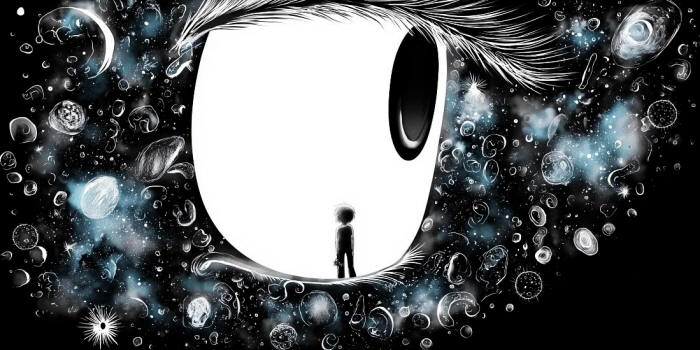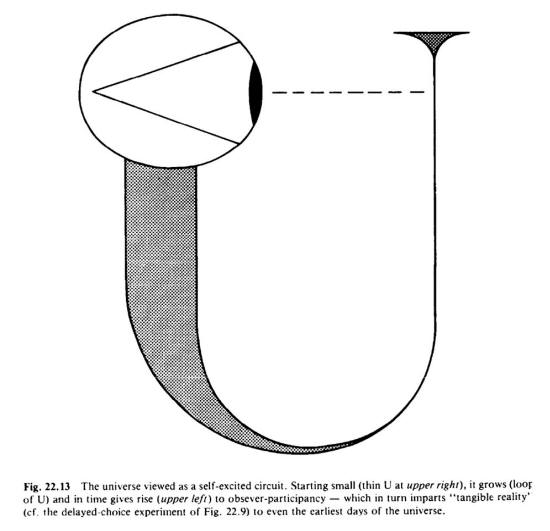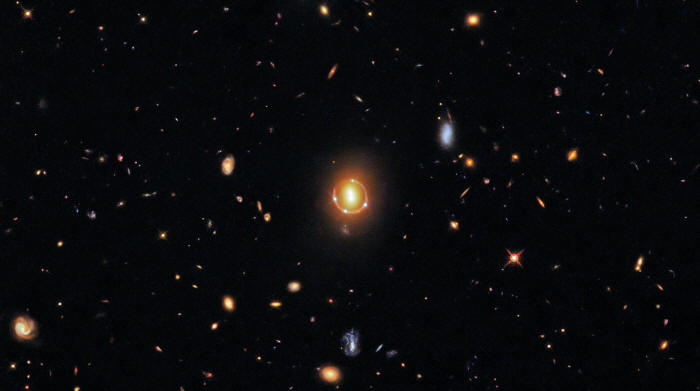|
Recovered through
WayBackMachine Website John Wheeler's illustration of a participatory universe.
It goes something like this.
His most quotable quip was the following.
Law Without Law. Quantum Theory and Measurement
If you're familiar with the idea of space as a seething boil of virtual particles popping in and out of existence, or if you've heard the words wormhole or black hole, then you've been in some way influenced by Wheeler.
His story is ripe with legacy, which is why you can find it in many other places and also why I won't retell it here.
Besides, I wouldn't do it justice, and I really only wanted to talk about one of his many ideas.
This is the famous wave-particle duality of
quantum physics - the photon acts as a particle if we interrogate
the path it took and as a wave if we do not.
You can read more about the modern version of the
double-slit experiment and its implications here:
Anyway, the photon sees the apparatus and turns on the appropriate behavior as it is entering it.
That is, if the photon enters an apparatus that checks which path it is going to take, it will turn on particle behavior. Otherwise, it will maintain wave behavior.
Presumably, if the photon chooses a path, it does
so at the moment (in our reference frame anyway) the possible paths
split.
Within a small laboratory experiment, this all seems academic.
But Wheeler was thinking on a cosmic scale.
In the image below, the "ring" is actually a single star nearly as old as the universe. The line between that star and Earth is blocked by another galaxy somewhere within the many billions of light-years between the star and us.
Yet, due to Einstein's relativity, the light from the star bends around the massive galaxy to reach us. (This sort of gravitational lensing was the first experimental proof of Einstein's theory, by the way.)
Image credit:
ESA/Hubble & NASA
The telescope used for the photo detects the path, and many photons project an image of a ring around the lensing galaxy.
Surely, if the light chooses one path or another, it did so many billions of years ago when it encountered the intervening galaxy.
Yet, how the photon manifests in the world is only decided up here and now, through the way we choose to arrange our telescope.
From your point of view,
I think of something, and you ask me yes or no questions with the hope of narrowing down my answers to reveal the one thing I was thinking about.
Suppose I was thinking about a kangaroo.
You ask,
Wow, you are good at this game.
But let's change it up a bit. Suppose there were 20 of us "answerers" and you had to ask each question to one person in succession.
You start with the first person:
You ask the next person,
The third person thinks a bit harder when you ask,
And so on it goes down the line, each person seeming to think a bit harder to answer.
Finally, you reach the last person,
From your perspective, the game is no different.
You assume the 20 people all agreed on the answer - transistor radio - before the game began. But here's the kicker. In this game of 20 Questions, each of the 20 participants agreed beforehand to not think of something.
The only thing they agreed to do was answer yes or no in a way that didn't contradict any previous answer.
The point is subtle, but obvious in hindsight.
Before you started asking the questions, there was no "answer." It was only through your choice of question that an eventual answer materialized in the world.
Wheeler called this "it from bit" - the physical world ("it") is brought about through asking it yes or no questions ("bits").
Turns out, it literally depends who's asking...
|




